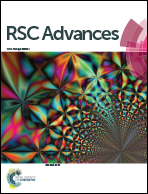Ligand slope, density and affinity direct cell polarity and migration on molecular gradient surfaces†
Abstract
We report a combined photochemical and electrochemical approach to generate model substrates that have molecularly defined gradients of ligands for studying cell migration and polarization. Our strategy utilizes a substrate bound with a photo-labile group protected redox active molecule that can be deprotected with ultraviolet light in patterns and gradients. The unveiled redox active molecule reacts selectively with soluble oxyamine tethered ligands for molecular level tailoring of the surface. This reaction is quantitative and can be monitored and controlled using cyclic voltammetry to determine the yield of reaction and therefore also to control the precise density of ligand on the surface. The surface is also designed to be inert to non-specific protein adsorption, thus the only interaction between cell surface receptors and the material is a ligand–receptor interaction, which is critical for studying the subcellular nano-architecture within cells during cell migration. We show the subtle interplay between ligand slope, ligand density and ligand affinity that causes a cell to modulate its adhesion and migration position and behavior during directed movement. We also show single cell polarity direction on gradient patterns is controlled by the presentation of peptides on the underlying surface.


 Please wait while we load your content...
Please wait while we load your content...